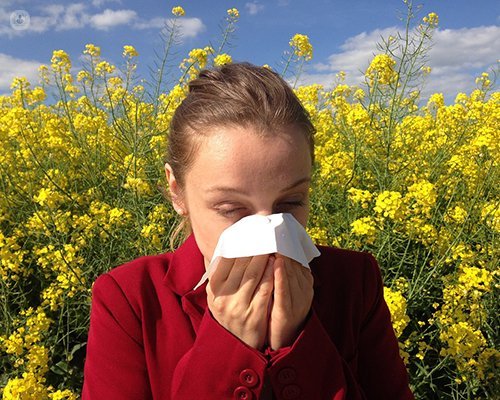respiratory allergies, how to control your symptoms
Written by:
What are the differences between allergies and respiratory infections?
 On the one hand, pulmonary infections can be both bacterial and viral upper airway, composed of the nostrils, mouth, pharynx and larynx; and lower, comprising trachea, bronchi and bronchioles. In the first can manifest pathologies such as sinusitis, laryngitis, croup, etc.. and second, bronchitis, pneumonia, etc.. Together they constitute a group of diseases that occur both in children and in adults, with a special boom in autumn-winter seasons and are valued queries Pneumology .
On the one hand, pulmonary infections can be both bacterial and viral upper airway, composed of the nostrils, mouth, pharynx and larynx; and lower, comprising trachea, bronchi and bronchioles. In the first can manifest pathologies such as sinusitis, laryngitis, croup, etc.. and second, bronchitis, pneumonia, etc.. Together they constitute a group of diseases that occur both in children and in adults, with a special boom in autumn-winter seasons and are valued queries Pneumology .
It is considered that rhinitis and allergic asthma are two manifestations of a single disease, respiratory allergy. In this case the causative factor is not a germ but an immune reaction to an external agent. Respiratory allergies are manifested when the person breathes susceptible particles capable of generating an immune reaction.
What kind of respiratory allergies exist?
The most common airborne allergens are found in grains of pollen from trees, grasses and plants in household dust, fungi in humidity and pets. Aeroallergens these particles are small so are located in the air and reach the nasal mucosa by inspired air. A very important part of our defenses are antibodies that are joined to these harmful agents and protecting eliminated.
However, allergy sufferers cause a special type of antibodies, IgE class excess. When IgE and allergen meet, an allergic reaction is triggered. If this happens in the nasal mucosa, rhinitis symptoms, which is the most common allergic disease occur but may progress to bronchial level causing allergic bronchial asthma to atopic.
What symptoms cause respiratory allergies?
When they contact an allergen and IgE antibodies synthesized by the person suffering from allergy an inflammatory disorder of the mucous membranes lining the inside of the nose, known as allergic rhinitis occurs. It is distinguished by nasal itching, sneezing, abundant mucus and nasal obstruction.
Allergic rhinitis affects between 10 and 25% of the population and causes a strong impact on their quality of life, because it reduces school and work performance and a major economic burden.
It is also a risk factor for developing asthma. Other common complications include sinusitis, nasal polyps and conjunctivitis.
Furthermore, the allergic bronchial asthma is an inflammatory disease of the bronchi which causes them to clog, thus impairing breathing. Clogging is due to an immunological reaction between the allergen and aspirate the antibodies generated by the allergic person.
Allergic asthma accounts for 70% of all types of asthma and the condition is most common in children and young adults chronic. Inflammation is related to bronchial occlusion (bronchospasm) and increased mucous secretion. In many cases, the bronchi also react in this way to respiratory infections, cold air or exercise (bronchial hyperreactivity).
Asthma symptoms are recurrent episodes of coughing, difficulty breathing (dyspnea), pressure in the chest and wheezing. Often asthma appears as crisis worsen and require emergency treatment. Asthma is accompanied by disturbances when the respiratory function tests (spirometry) that helps confirm the diagnosis, determine its severity and knowing the response to treatment is performed.
Often, allergic asthma is associated with spasmodic cough and allergic rhinitis, which may precede in time.
How this type of allergies treated?
Treatment for respiratory allergy, once properly diagnosed and certain allergens which are responsible, is based on three main aspects that can complement:
- Prevent exposure to the allergen, which may be sufficient to control the disease, especially in the case of specific allergies animal dander. It is virtually impossible to avoid exposure to the vast majority of environmental allergens (mites, pollens and fungi), but taking some hygienic measures can reduce this exposure.
- Drug delivery resulting on symptoms such as antihistamines, anti - inflammatories or bronchodilators or inhaled corticosteroids. It should be considered that the positive effect disappears when you stop the medication. It is important to spirometric checks to see an evolution of bronchial asthma.
- Desensitizing immunotherapy is considered the most complete treatment for respiratory allergy and is achieved through allergy shots. Specific immunotherapy can achieve immune tolerance after a long-term treatment and always with control by the specialist.


